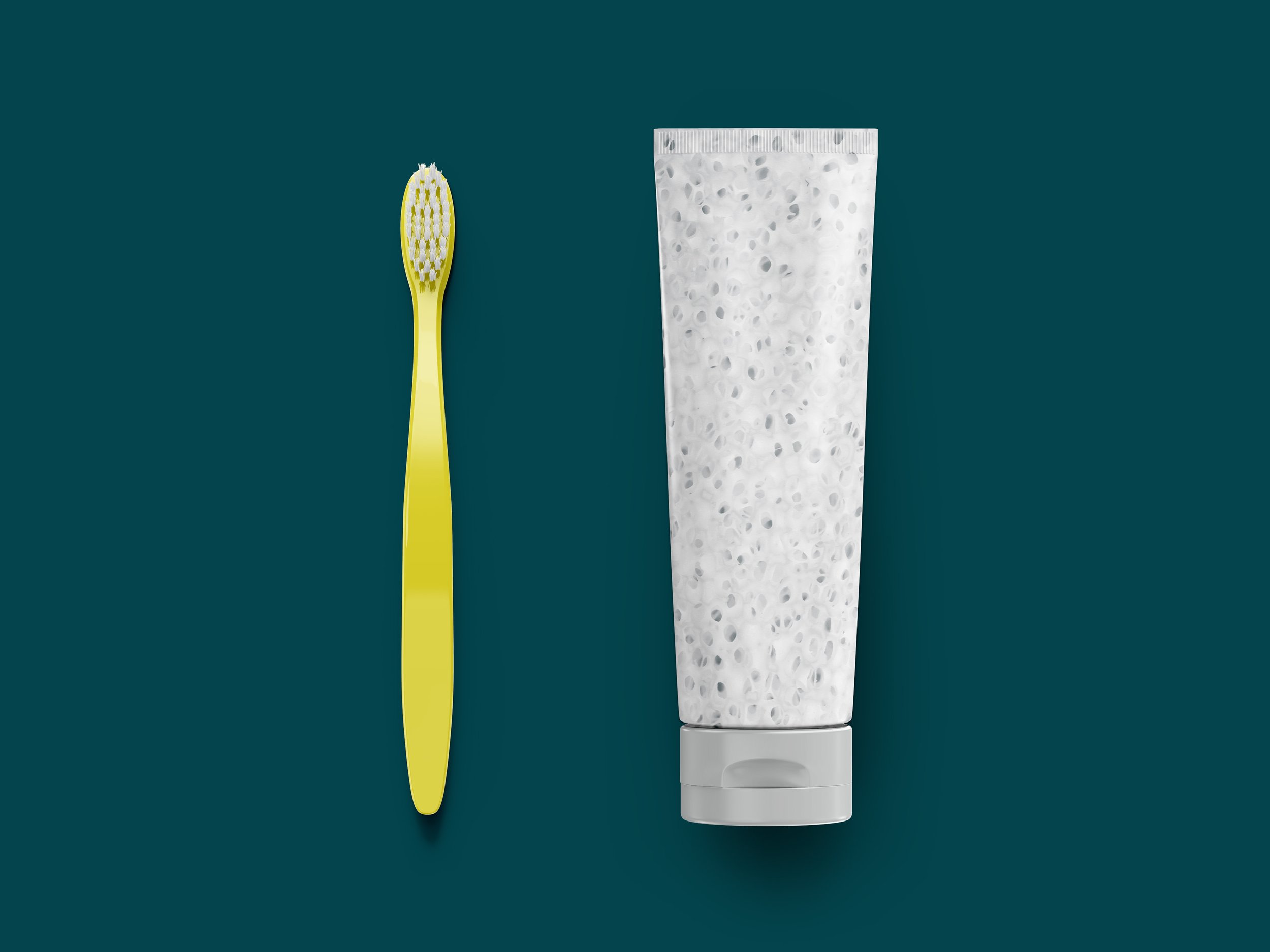Exploring the Benefits of Hydroxyapatite in Toothpaste
Updated: April 9, 2025
For those seeking an alternative to fluoride toothpaste, there’s good news: it’s possible to maintain strong, cavity-resistant teeth without giving up effective protection. Hydroxyapatite—a naturally occurring mineral—has been gaining popularity as a toothpaste ingredient due to its ability to remineralize tooth enamel and help prevent cavities. In fact, a recently updated review and meta-analysis of research on hydroxyapatite indicates that an increasing number of clinical studies confirm hydroxyapatite’s benefits (1).
However, many people just learning about hydroxyapatite naturally have some key questions:
What exactly is it?
How does it work?
Is it safe?
As a biomaterials company, Himed has worked with hydroxyapatite for nearly 35 years. In this article, we’ll offer a clear overview of this compound and explain why it’s becoming a promising ingredient in modern oral care products.
What is hydroxyapatite?
Hydroxyapatite (HA) is a naturally occurring calcium phosphate and the primary mineral component of human bones and teeth. In the mouth, it makes up over 90% of tooth enamel—the hard, protective outer layer—and about 70% of dentin—the softer supportive layer underneath (2).
Enamel is the hard, outermost layer of the tooth. Dentin is a bit softer and provides support to the enamel while protecting the inner layers of the tooth. Both are largely made up of hydroxyapatite.
HA has been used for decades in both medical and dental applications, including bone grafts and implant coatings. It can be harvested from sources like animal bones or eggshells, or it can be synthesized in a lab. At Himed, we manufacture synthetic HA specifically for biomedical uses because these forms can be engineered to very closely mimic the mineral structures found in hard tissues like dental enamel and human bone.
Hydroxyapatite also happens to be bioactive—meaning it has properties that allow it to interact successfully with surrounding cells to support the body’s natural healing and regenerative processes (3).
When used as an additive in toothpastes, hydroxyapatite exists in a very fine powder form, but under a powerful scanning electron microscope, the granular nature of even the finest powders is visible. Pictured here is Himed’s solid-state sintered MC-type HA with a size range of < 53 μm (Cat#MCHA20).
How does hydroxyapatite in toothpaste work?
To understand how hydroxyapatite toothpaste protects your teeth, it helps to know how tooth damage occurs in the first place. Two common types of damage are dental caries, also known as cavities, and erosive tooth wear. Though they may look similar at first, they have different causes.
Erosive tooth wear is typically caused by exposure to acids from non-bacterial sources, such as citrus fruits, carbonated drinks, or gastric acid from a condition like acid reflux (4).
Cavities, on the other hand, are caused by acids produced by bacteria in the mouth (5). When oral bacteria digest sugars and carbohydrates in dental plaque, they create an acidic environment that strips calcium and phosphate from tooth enamel—a process known as demineralization (6).
If demineralization progresses without intervention, it can lead to sensitivity, discoloration, infections, or even tooth loss. Since enamel cannot regenerate organically, restoring lost minerals requires outside support. This is where ingredients like fluoride and hydroxyapatite play a critical role (6).
A form of hydroxyapatite called nano-hydroxyapatite, or nHA, is commonly used in toothpaste. While there is currently no single standard for what qualifies as “nano” HA, the dental industry broadly identifies it as a type of synthetic HA with a micro-crystalline structure. It not only helps prevent plaque but also fills in tiny areas of mineral loss on the tooth surface. In doing so, it restores strength to enamel and helps reverse early signs of decay. Several studies comparing nano-hydroxyapatite and fluoride have shown that nHA can remineralize teeth just as effectively—and in some cases, even more thoroughly—than fluoride-based products (6).
Hydroxyapatite vs. fluoride
Most of us are more familiar with fluoride, which has long been an effective staple in anticavity toothpastes. Like hydroxyapatite, fluoride helps remineralize enamel and reduce decay. However, there are some key differences worth noting.
Fluoride doesn’t contain calcium or phosphate itself. Instead, it works by drawing these minerals from saliva and forming a protective substance called fluorapatite, which bonds to weakened areas of enamel. This process has been proven effective, but it depends on the availability of minerals in the mouth and doesn't always lead to deep remineralization.
Hydroxyapatite, by contrast, supplies calcium and phosphate directly. Because its composition mimics that of natural enamel, it can easily integrate into the tooth’s structure. In some recent studies, HA-based toothpaste has shown the ability to remineralize a bit more thoroughly than fluoride, reaching deeper layers of damaged enamel rather than only rebuilding the surface (1,7), however more testing would be necessary to fully understand the conditions impacting the remineralization effects of HA vs. fluoride.
What other benefits does hydroxyapatite toothpaste offer?
In addition to remineralization, hydroxyapatite may offer several other oral health benefits. Research from the University of Toronto in 2021 found that HA toothpaste produced noticeable whitening effects, something fluoride alone does not offer (8). It also appeared to reduce symptoms of dentin hypersensitivity, which is a common issue for many adults.
Other studies have shown that hydroxyapatite may help reduce bad breath by limiting the growth of certain bacteria, especially when combined with complementary ingredients like zinc or silver (9). This is why you’ll often see zinc citrate or nano-silver listed in HA toothpaste formulations. These additions help improve oral health without the need for strong antibacterial agents that might disrupt the natural balance of the mouth.
Is hydroxyapatite toothpaste safer than fluoride toothpaste?
While fluoride remains a safe and effective ingredient when used as directed, its safety profile has some limitations—especially for young children who are more likely to ingest it. Ingesting too much fluoride can cause intestinal discomfort, and over time, contribute to conditions like dental fluorosis, which causes white or brown discoloration of teeth, or skeletal fluorosis, which can lead to stiffness and pain in bones and joints (10).
Patches of white discoloration on tooth enamel indicate a mild form of dental fluorosis, caused by an excess of fluoride coming into contact with tooth enamel. Image by Matthew Ferguson 57 via Wikimedia Commons, licensed under the Creative Commons Attribution-Share Alike 4.0 International License.
Hydroxyapatite, on the other hand, has not been associated with any concerning side effects (11); in fact, one of its admirable properties is its high level of biocompatibility (12). This means that it’s non-toxic to the human body overall, does not harm cells in the mouth, and causes minimal inflammatory responses.
Another often-overlooked distinction is that fluoride’s antimicrobial action can affect both harmful and helpful bacteria in the mouth. While reducing decay-causing bacteria is beneficial, fluoride’s broad action may unintentionally disrupt the balance of oral microbiota, which play an important role in digestion and immune defense.
One of hydroxyapatite’s benefits, fortunately, is its lack of antimicrobial properties (12). Especially when paired with zinc, hydroxyapatite has shown the ability to prevent the formation of plaque while protecting helpful mouth bacteria. It also has been shown to reduce symptoms of gum diseases like periodontitis and gingivitis, such as bleeding and inflammation. This is thought to be because it hinders bacteria from sticking to the enamel and other surfaces in the mouth.
Can I buy hydroxyapatite toothpaste?
While it may be tougher to find in retail stores, you can easily buy hydroxyapatite toothpaste online. There are many popular brands now which have been well-reviewed. Hydroxyapatite is also appearing in mouthwashes, tooth gels, and even tube-free tooth powders and tablets. However, before using any product containing hydroxyapatite, you should always consult an oral care professional to determine whether hydroxyapatite is a good fit for you.
At Himed, we’ve supplied biomaterials like hydroxyapatite for more than three decades. We’re excited to see this safe, effective compound being used to support healthier, more resilient smiles—and to give people more options when it comes to their daily oral care.
References
Hydroxyapatite: A journey from biomaterials to advanced functional materials
The use of hydroxyapatite toothpaste to prevent dental caries
University of Toronto researchers show effectiveness of fluoride-free hydroxyapatite toothpaste
Nano-hydroxyapatite in oral care cosmetics: characterization and cytotoxicity assessment
NOTE: Every effort has been made to ensure the accuracy of the information shared in this post at the time of publication. This content is not intended as medical advice and should not be used in place of consultation with a qualified healthcare provider. If you believe any part of this post is inaccurate or could benefit from an update, please contact us.




